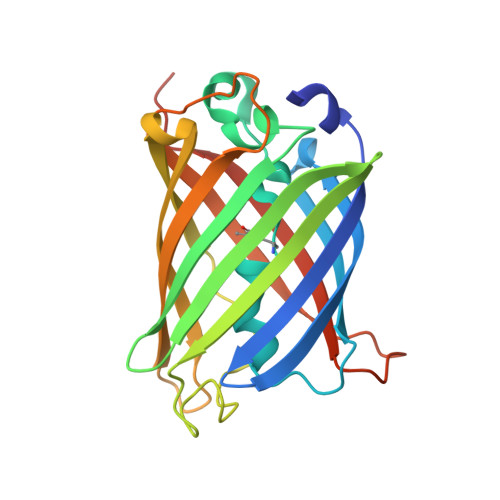Understanding GFP Chromophore Biosynthesis: Controlling Backbone Cyclization and Modifying Post-translational Chemistry.
Barondeau, D.P., Kassmann, C.J., Tainer, J.A., Getzoff, E.D.(2005) Biochemistry 44: 1960-1970
- PubMed: 15697221
- DOI: https://doi.org/10.1021/bi0479205
- Primary Citation of Related Structures:
1YHG, 1YHH, 1YHI, 1YJ2, 1YJF - PubMed Abstract:
The Aequorea victoria green fluorescent protein (GFP) undergoes a remarkable post-translational modification to create a chromophore out of its component amino acids S65, Y66, and G67. Here, we describe mutational experiments in GFP designed to convert this chromophore into a 4-methylidene-imidazole-5-one (MIO) moiety similar to the post-translational active-site electrophile of histidine ammonia lyase (HAL). Crystallographic structures of GFP variant S65A Y66S (GFPhal) and of four additional related site-directed mutants reveal an aromatic MIO moiety and mechanistic details of GFP chromophore formation and MIO biosynthesis. Specifically, the GFP scaffold promotes backbone cyclization by (1) favoring nucleophilic attack by close proximity alignment of the G67 amide lone pair with the pi orbital of the residue 65 carbonyl and (2) removing enthalpic barriers by eliminating inhibitory main-chain hydrogen bonds in the precursor state. GFP R96 appears to induce structural rearrangements important in aligning the molecular orbitals for ring cyclization, favor G67 nitrogen deprotonation through electrostatic interactions with the Y66 carbonyl, and stabilize the reduced enolate intermediate. Our structures and analysis also highlight negative design features of the wild-type GFP architecture, which favor chromophore formation by destabilizing alternative conformations of the chromophore tripeptide. By providing a molecular basis for understanding and controlling the driving force and protein chemistry of chromophore creation, this research has implications for expansion of the genetic code through engineering of modified amino acids.
Organizational Affiliation:
Department of Molecular Biology, The Skaggs Institute for Chemical Biology, The Scripps Research Institute, 10550 North Torrey Pines Road, La Jolla, California 92037, USA.
















